Middle-Earth: Shadow of Mordor – Review
by Edward

|
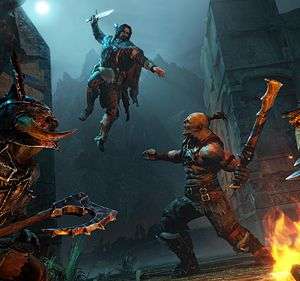 One of the biggest problems of games set in previously-established universes is that there’s a great temptation to play hard and fast with what’s already been set out, and it’s one that all too many succumb to. Eventually, as was the case with Star Wars: The Force Unleashed and others of its ilk, these are promptly ejected from the franchise canon and only spoken about in hushed tones or otherwise ignored and forgotten. With that in mind, some would approach Middle-Earth: Shadow of Mordor with some great trepidation, but they’d be sorely mistaken to do so. For one, Shadow of Mordor is part of its own alternative continuity that combines the worlds of both the novels and films, and takes place between the events of The Hobbit and the Lord of the Rings trilogy. Second, it’s undoubtedly the best game to ever form part of that universe, and if you’ve ever cared about orcs, Sauron and not simply walking to places, then you’d be a fool of a Took to give this a miss.
One of the biggest problems of games set in previously-established universes is that there’s a great temptation to play hard and fast with what’s already been set out, and it’s one that all too many succumb to. Eventually, as was the case with Star Wars: The Force Unleashed and others of its ilk, these are promptly ejected from the franchise canon and only spoken about in hushed tones or otherwise ignored and forgotten. With that in mind, some would approach Middle-Earth: Shadow of Mordor with some great trepidation, but they’d be sorely mistaken to do so. For one, Shadow of Mordor is part of its own alternative continuity that combines the worlds of both the novels and films, and takes place between the events of The Hobbit and the Lord of the Rings trilogy. Second, it’s undoubtedly the best game to ever form part of that universe, and if you’ve ever cared about orcs, Sauron and not simply walking to places, then you’d be a fool of a Took to give this a miss.
The story begins when Talion, a ranger of Gondor, tasked with guarding the Black Gate of Mordor, is murdered alongside his family by the forces of Sauron who are preparing for the re-arrival of their Dark Lord. However, our hero is rather surprised to discover that his execution didn’t quite stick, thanks to the arrival of a mysterious Wraith who co-opts his body and keeps Talion attached to the realm of the living so that he can exact his revenge against Sauron. Seeking his own brand of vengeance against the Dark Lord, and now imbued with Wraith-like powers, the former ranger of Gondor is more than happy to help lay waste the lands of Mordor before being reunited with his dead wife and child.
With that kind of synopsis, it’s hard not to find the story of Shadow of Mordor a bit hokey and trite at the best of times, and you’d be totally right in thinking that. At its very core, it’s a simple revenge story with more than a few clichés and revelations thrown in, and you’ll spot most of them coming from a mile off: you’ll team up with people who you can’t totally trust and who aren’t quite telling you everything, there’s a comic-relief sidekick early on, and there’s a woman whose future role as a damsel in distress is so heavily signposted that her character arc may as well be a journey on the M25. In fact, there’s actually a later level where you have to carry her out of danger using a carry mechanic that’s only employed for that one section. They willingly coded in a sequence that’s solely used to undermine one of the only women in the game and reduce her to an object that needs saving. It’s a mission that leaves a particularly bitter taste when the rest of the Tolkien universe is otherwise full of strong female characters.
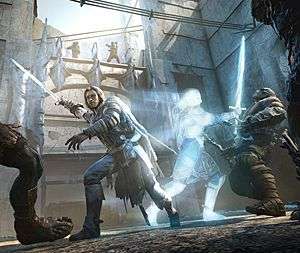 Overall, the story takes a half-decent stab at an attempt to make an official alternative continuity, but there are plenty of occasions where its lack of self-confidence is all-too evident. You’ll barely be three missions in before Gollum shows up, and although he doesn’t feel like he’s been shoehorned in for the sake of it there’s a great whiff of fan-service about the whole affair, especially when his total contribution to the plot could easily have been handled by literally anyone else. It’s a welcome piece of familiarity and the sound-alike voicing him is virtually indistinguishable from Serkis, but it’s a cameo the story could easily have been done without (meanwhile, you can tell Troy Baker voiced Talion because he’s a main character who happens to be a bland white guy whose sole characterisation is the loss of family members).
Overall, the story takes a half-decent stab at an attempt to make an official alternative continuity, but there are plenty of occasions where its lack of self-confidence is all-too evident. You’ll barely be three missions in before Gollum shows up, and although he doesn’t feel like he’s been shoehorned in for the sake of it there’s a great whiff of fan-service about the whole affair, especially when his total contribution to the plot could easily have been handled by literally anyone else. It’s a welcome piece of familiarity and the sound-alike voicing him is virtually indistinguishable from Serkis, but it’s a cameo the story could easily have been done without (meanwhile, you can tell Troy Baker voiced Talion because he’s a main character who happens to be a bland white guy whose sole characterisation is the loss of family members).
The worst criticism I can really offer to the story is that, at best, it just exists. Talion is so bland and characterless that all I could tell you about him after twenty-one hours of gameplay is that he’s a bit miffed that his family died and he’s also a bit sarcastic, sometimes. Otherwise, the story meanders through encounters with people you barely know or get time to care about before the lacklustre and uneventful ending happens. At times it almost feels like there were meant to be some opening missions which were cut out and replaced with the tutorial, or at least some extra missions mid-game, as there are a couple of moments where characters you barely know will reference events as if you directly took part in them.
Some of the story’s overall misfortunes can be tied to the fact that the developers either needed to focus on fewer characters or create more main story missions. With only twenty missions to plough through, there simply aren’t enough moments for you to get acquainted with the myriad of characters, some of whom will only feature in two or three missions, which isn’t enough time to properly learn their names, let alone their plights. It just makes the ensuing tale hard to care about at best, and boring at worst, making it by far the weakest part of a game where nearly everything else is a joy to behold.
Effortlessly combining an open-world with a robust stealth mechanic and a combat system that more than cribs from a certain other Warner Bros. property, Shadow of Mordor feels like the developers took the best parts of some of the most renowned series of the last few years, put them in a melting pot with some Tolkien lore and a rudimentary knowledge of alchemy, and ended up with solid gold. It’s a title that could so easily have felt like a lumbering Frankenstein’s monster of its various influences, but manages to come across as something unique without being strangled by the constraints of having to fit into the Lord of the Rings universe.
While the player will have to slowly accustom themselves to the lay of the land and learn the best ways to utilise stealth, the combat will be more than familiar to those who’re well-acquainted with Rocksteady’s Arkham series. If you were particularly cruel, you could easily levy the accusation that Shadow of Mordor‘s combat is nothing more than a copycat of Batman’s particular brand of fisticuffs and, in the early stages especially, it’s particularly hard to refute that.
 |
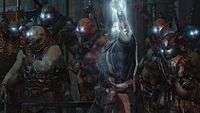 |
 |
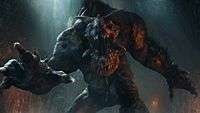 |
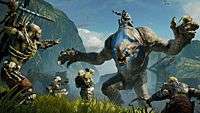 |
 |
Enemies will come at you in groups, allowing you to attack them, counter them as they’re about to attack you, dodge their attacks and leap over foes to get to another target, and even stun them so you can fire off a series of quick hits and build up your hit counter with slightly less fear of retaliation. After hitting certain milestones without being hit and losing your combo, you can even unlock and unleash moves that stun everyone within a certain radius or instantly take someone out of the fight. The control scheme for all of these actions and special moves are tied to exactly the same layout as the Batman games.
The differences, then, are somewhat more subtle. For one, it feels far more fast-paced and fluid than the Dark Knight’s combat, while still managing to retain the same level of impact for each hit and slash of the sword. Another big difference is that there are no major enemies that completely destroy the flow of combat once they’re introduced; some will have invulnerabilities to certain moves or attacks, but these are often ones that you can discover beforehand and adapt to as needed.
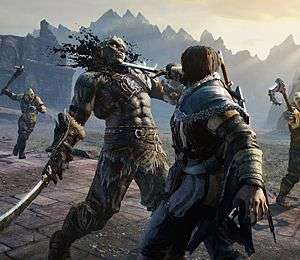 Shadow of Mordor has precisely none of this; there are enemies with shields, but hitting them won’t break your combo and punish you, and while there are archers and enemies that can throw spears at you, you can easily dodge them if you see them coming, while getting hit by them won’t eliminate most of your health bar. If you’re about to be cut down, there’ll be a short QTE that gives you the chance of a second wind, and later on will allow you to kill the foe that was just about to end you. The average fight in Shadow of Mordor will often see you slashing away at nearly a dozen or so uruks. As a result, the combat feels a lot harder and a great deal more tense, especially in the early stages. This is somewhat exacerbated by the fact that once you’re engaged in a fight it’s a great deal harder to escape it, so in the first few hours it’s often a case of laying waste to everyone around you or leaving in a body-bag.
Shadow of Mordor has precisely none of this; there are enemies with shields, but hitting them won’t break your combo and punish you, and while there are archers and enemies that can throw spears at you, you can easily dodge them if you see them coming, while getting hit by them won’t eliminate most of your health bar. If you’re about to be cut down, there’ll be a short QTE that gives you the chance of a second wind, and later on will allow you to kill the foe that was just about to end you. The average fight in Shadow of Mordor will often see you slashing away at nearly a dozen or so uruks. As a result, the combat feels a lot harder and a great deal more tense, especially in the early stages. This is somewhat exacerbated by the fact that once you’re engaged in a fight it’s a great deal harder to escape it, so in the first few hours it’s often a case of laying waste to everyone around you or leaving in a body-bag.
Admittedly, I found myself suffering the latter fate far more often in the early stages of the game, and it was here that I became properly introduced to the nemesis mechanic. Throughout your adventure you’ll repeatedly come up against the forces of Sauron’s army and the various hierarchies that permeate it, and it’s this feature that helps propel Shadows of Mordor into the echelons of something beautiful.
You see, Sauron’s army comes with its own intricate political system, containing Captains, Warchiefs, their bodyguards and their second-in-commands. As you throw yourself into various skirmishes across the realm, you’ll often find that a major figure isn’t far behind, each with their own unique names, attributes and weaknesses. One might be invulnerable to stealth attacks, but run away at the site of the vicious beasts known as caragors. Another might get enraged and thus more dangerous if you set him on fire, but will be felled instantly by a well-placed arrow to the head. The higher they rise through the ranks, the fewer weaknesses they’ll possess, with a nightmarish scenario being a shielded foe who can block everything you throw at him but combat finishers, although he’ll also yield the greatest rewards if you manage to take him down.
By collecting various intel scattered about the map, freeing slaves, or interrogating certain foes, you can discover the most prominent members of Sauron’s army, their location and their weaknesses, allowing you to put together a plan to take them on, or seek revenge if they’ve dispatched you one too many times. It’s a system that can completely change the way you approach each battle, and also means that every fight could result in a story or anecdote completely unique to you.
 In the opening stages of the game I’d fallen to an ordinary foe who rose to the rank of Captain as a reward for disposing of me, and my subsequent attempts to seek revenge were so ill-fated that within twenty minutes I’d accidentally positioned him as a Warchief’s personal bodyguard. I finally got my revenge and put a stop to him, only to be killed by a lower-ranked Captain as I was attempting to flee the battlefield to fight another day. On the way to seeking my revenge against him, I was taken out by another uruk, who was promoted as well, who then challenged the foe I was attempting to seek revenge against and won, denying me the chance to get my own back.
In the opening stages of the game I’d fallen to an ordinary foe who rose to the rank of Captain as a reward for disposing of me, and my subsequent attempts to seek revenge were so ill-fated that within twenty minutes I’d accidentally positioned him as a Warchief’s personal bodyguard. I finally got my revenge and put a stop to him, only to be killed by a lower-ranked Captain as I was attempting to flee the battlefield to fight another day. On the way to seeking my revenge against him, I was taken out by another uruk, who was promoted as well, who then challenged the foe I was attempting to seek revenge against and won, denying me the chance to get my own back.
Even more interesting is that, while you can dismantle Sauron’s forces piece by piece, that doesn’t mean that those enemies are gone forever, and they’ll remember how your last confrontation went down. You ran away? They’ll taunt you for it. Did they kill you? They’ll want your head as a trophy to prove they’ve finished the job. Attacked them while riding on the back of a caragor? They’ll ask where your little pet is so they can kill that, too. Stabbed them through the head? Part of their head will be covered with metal. Set them on fire? They’ll wear a helmet to cover their burns. Unless you decapitate them or explode their head with your wraith powers, there’s a likelihood they’ll come back and want to make you regret it.
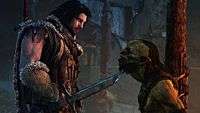 |
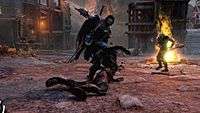 |
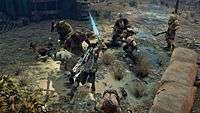 |
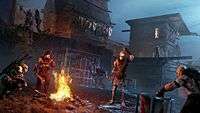 |
 |
 |
Their presence won’t just come from random battles, as later on you can arrive at specific events that allow you to disrupt the chain of command and further establish your dominance. You can show up to their power struggles and put a blade through their heads, halt arranged executions and even ruin their feasts, should you so choose. Later on in the story you’ll receive the ability to brand them with your Wraith powers and turn them into your mind-controlled slaves, and this opens up even further avenues to play with. Instead of interrogating a Captain, you can get him to send a death threat to someone else, which’ll raise their defences but yield greater rewards for dispatching them. Rather than cut their heads off, you can brand them and use them as unwilling pawns and install your own hierarchy in Sauron’s ranks. It starts legitimately changing the way you approach the second half of the game, and keeps fresh an already in-depth and intriguing mechanic for that much longer.
These brilliant mechanics aside, they’d have far less impact if the open-world wasn’t any fun to explore, or felt limited in scope. Fortunately, the land of Mordor is an utter joy to explore and play in. It’s clear from the offset that Shadow of Mordor was a game designed with its open-world in mind; rather than creating the sandbox first and then struggling to find organic missions to put in it later, it feels like each dictated the other, with each mission and piece of land evolving when the other called for it.
As a result, specific missions and side-quests can often be tackled in any way that you want to, thanks to how the world is designed. There are so many ways to explore each stronghold and major landmark that you’re often spoiled for choice; you don’t get punished for doing it the wrong way because there isn’t one, there’s only the way you want to approach it, and you’re accommodated for whether you want to go in arrows blazing, on the back of a caragor, or so sneakily that you may as well be a literal ghost, rather than revived by one.
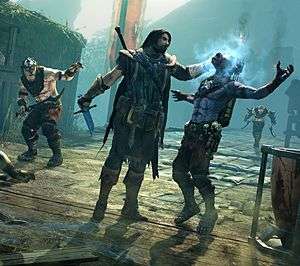 In a rare turn-up for an open-world game, the stealth is actually a joy to play and is a viable option, rather than a terribly-inserted mechanic for use in mandatory stealth sections where you’re seen once and instantly fail. There are often multiple avenues or paths to take should you stick to the shadows, and you’ll find yourself raking in more experience points if you’re a consistently sneaky killer. Climbing around the environment is an utter joy, compounded by the knowledge that you could, at any moment, dive from a ledge, stab someone and slink back to the shadows with nary a care in the world. Enemies are visible on your mini-map and highlighted whenever you enter the Wraith World – like Batman’s Detective Vision but slightly less useful and nowhere near as game-breaking – allowing you to forge your own path and tackle them in whatever order you like.
In a rare turn-up for an open-world game, the stealth is actually a joy to play and is a viable option, rather than a terribly-inserted mechanic for use in mandatory stealth sections where you’re seen once and instantly fail. There are often multiple avenues or paths to take should you stick to the shadows, and you’ll find yourself raking in more experience points if you’re a consistently sneaky killer. Climbing around the environment is an utter joy, compounded by the knowledge that you could, at any moment, dive from a ledge, stab someone and slink back to the shadows with nary a care in the world. Enemies are visible on your mini-map and highlighted whenever you enter the Wraith World – like Batman’s Detective Vision but slightly less useful and nowhere near as game-breaking – allowing you to forge your own path and tackle them in whatever order you like.
All uruks come with their own suspicion meter; an indicator filling up to yellow means they’ve spotted you or your handiwork, briefly, or are on the look out for you, while red means they’ve found you and are coming your way. Being caught isn’t an instant failure, because as long as you take them down before they start fighting or can sound the alarm, then you can continue sneaking around without being forced into a brawl. Later in the story you can also learn the ‘brutalise’ ability, which allows you to sneak up and utterly eviscerate a foe, causing any enemies in the immediate area to flee in abject fear – also a viable tactic if you want to clear an area without getting caught up in a multi-man melee.
If you particularly want to hone your sneaking skills, then you can always throw yourself into one of the many side-missions scattered about Mordor. Each weapon you carry can be forged into legend by taking part in a series of weapon-specific missions. Missions for your blade will see you take down various hordes of enemies in a variety of fighting styles; ones for your bow will ask you to pull off some deft long-range murder, while legends for your dagger will ask you to make your way through a variety of increasingly difficult stealth missions. Successful completion of each one will not only give you some experience, but will also provide you with reward points that you can use to level Talion further.
Levelling your hero is divided into two separate fields – experience or reward points. The former grant you new abilities and are tiered off by your power level, necessitating participation in the occasional power struggle to unlock every new trick and move. The latter are more generally focused, allowing you to increase your health bar, your focus bar, how many arrows you can fire, and how many relics you can attach to each of your weapons. It’s a great way to allow players more freedom in the way they choose to level Talion, made more intriguing by the fact that you can’t necessarily get every upgrade or ability unless you invest some serious time on the side-quests.
 Somewhat less necessary are the artefacts and inscribings you can find on your travels. There are plenty to find of each, but they don’t do much other than provide you with a small amount of points to spend on upgrades. None are particularly hard to find and, early on, they reap some benefit, but by the second half of the game most of the side missions give you a far greater reward, so there’s less incentive to find all the artefacts or complete the mural, other than completion stats and a bit of world building. However, one incentive to keep exploring is to soak in the beautiful and immersive lands of Mordor. The environments are often breathtaking and vibrant, landmarks unique in their construction and daunting to approach and, above all, the landscape is memorable – a must in a game with so many paths to explore. Also commendable is the fact that most of the cut-scenes look like they’ve been made in-game. Trying to don an alternative costume will put rest to that idea, but the graphics during gameplay look so similar to their cut-scene counterparts that it’s hard not to be impressed.
Somewhat less necessary are the artefacts and inscribings you can find on your travels. There are plenty to find of each, but they don’t do much other than provide you with a small amount of points to spend on upgrades. None are particularly hard to find and, early on, they reap some benefit, but by the second half of the game most of the side missions give you a far greater reward, so there’s less incentive to find all the artefacts or complete the mural, other than completion stats and a bit of world building. However, one incentive to keep exploring is to soak in the beautiful and immersive lands of Mordor. The environments are often breathtaking and vibrant, landmarks unique in their construction and daunting to approach and, above all, the landscape is memorable – a must in a game with so many paths to explore. Also commendable is the fact that most of the cut-scenes look like they’ve been made in-game. Trying to don an alternative costume will put rest to that idea, but the graphics during gameplay look so similar to their cut-scene counterparts that it’s hard not to be impressed.
Similarly, it’s tough not to get pulled in by the soundtrack, at times. It’s often pitched perfectly to the action around you, and does well to keep you heavily immersed in the action without overpowering the experience at any point. Its best employment is by far during the confrontations with the various Warchiefs, as their arrival will be punctuated by a group chant of their name, adding immensely to the atmosphere of the coming confrontation.
While I managed to keep myself immersed in Shadow of Mordor for around twenty hours, it wasn’t without its difficulties. The opening couple of hours are more difficult than they need to be thanks to the game throwing you into the world with little instruction or explanation of how to do things, other than a bare-bones tutorial. The HUD can be quite messy at the best of times, and the menu system is far more convoluted than it needs to be. And there’s a boss fight that involves you having to dive out of the way of a giant charging monster so it hits a wall and stuns itself so you can attack it.
I occasionally found myself coming across weird glitches where Talion would struggle to climb something, get confused at what the contextual command was trying to get him to do, or get stuck on a bit of the scenery and be left rolling around until I suddenly got him free. Frustratingly, I found myself dying a few times mid-battle because of that particular issue. By far the weirdest glitch, however, was when the game rendered part of a location in eye-piercingly bright colours like everything was suddenly lens flare in a JJ Abrams movie, yet expected me to take on an uruk Captain without being able to see anything that was going on.
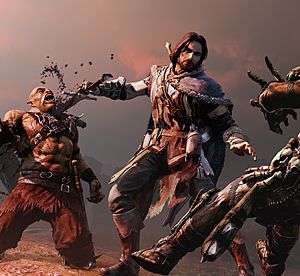 However, those issues were often made up for by some wonderful examples of emergent gameplay. Shadow of Mordor is full of moments you can’t help but want to share with your friends in case they’re entirely unique to your experience. In the middle of a skirmish with twenty or so uruks, the action paused and the camera flew away to the other side of the stronghold where a Warchief’s bodyguard was successfully mauled to death by a caragor that just happened to be roaming the area. After letting loose a nest of morgai flies, I saw an archer throw himself off the side of the castle and into the water below rather than be attacked by the little buzzers. My personal favourite by far was chasing my then-nemesis halfway across the map, only for him to run past a cave where a graug was emerging, which responded to the uruk’s presence by stomping him to death and chasing after me instead.
However, those issues were often made up for by some wonderful examples of emergent gameplay. Shadow of Mordor is full of moments you can’t help but want to share with your friends in case they’re entirely unique to your experience. In the middle of a skirmish with twenty or so uruks, the action paused and the camera flew away to the other side of the stronghold where a Warchief’s bodyguard was successfully mauled to death by a caragor that just happened to be roaming the area. After letting loose a nest of morgai flies, I saw an archer throw himself off the side of the castle and into the water below rather than be attacked by the little buzzers. My personal favourite by far was chasing my then-nemesis halfway across the map, only for him to run past a cave where a graug was emerging, which responded to the uruk’s presence by stomping him to death and chasing after me instead.
Although many would no doubt be hesitant of a game written as an alternative canon to the Lord of the Rings books and films before it, there’s no doubt Middle-Earth: Shadow of Mordor is a success. It may crib liberally from the series that inspired it, and its story may be one of the most bland, boring offerings in a franchise whose most famous tale is “people walk to a volcano and throw a ring in it“, but when it comes to the gameplay, it manages to get everything spot-on. It’s a beautiful open-world with an incredibly deep nemesis system that makes your deaths and failures meaningful and keeps you coming back for more with nary a second of hesitation. It’s undoubtedly the best game attached to the works of Tolkien, and, were it not for its lacklustre story and myriad flaws, could easily have been a serious contender for Game of the Year.
Pros- A beautiful open-world that's a pleasure to explore and is clearly designed around the gameplay
- A plethora of content that will keep you playing for around twenty hours if you want to see everything
- A great evolution of the combat from Rocksteady's Arkham series that keeps encouraging you to get stuck into battle after battle
- The Nemesis system is a brilliant new mechanic that keeps the action varied and helps make battling a continued joy
- The excellent stealth mechanic rewards you for experimentation, rather than failing you the instant you're seen
- Emergent gameplay gives you plenty of 'water-cooler moments' to discuss with your friends
- The soundtrack keeps you immersed in the gameplay and compliments most of the action...
- ...But it's all too easy to accidentally tune it out
- The HUD can be a bit of a mess, while the menu systems are one
- Some odd flaws can often bring the immersion screaming to a halt
- A boring, bland story filled with barely-characterised people for whom you aren't given enough time to care about
- There's a horribly patronising section with a mechanic never used elsewhere that forces you to carry a distressed damsel out of trouble and protect her because she can't defend herself
Taking such an established and well-loved universe as that of Tolkien's Lord of the Rings and trying to create your own story within it is hardly going to be the easiest of tasks, and it's not one that Middle-Earth: Shadow of Mordor entirely succeeds in doing. The story's a bit of a bland mess of characters you'll struggle to remember or care about by the time the credits roll, but everything else about the game is essentially spot-on.
An amazing combination of open-world gameplay mixed with a combat system that takes more than a few cues from Rocksteady's take on Batman, some brilliant stealth mechanics and the truly inspired nemesis feature make Shadow of Mordor an utter joy to play. You'll be hard-pressed not to keep playing until you've finished it one-hundred percent, and then you'll have to battle with the temptation to start playing it through all over again. It's just a shame that some persistent niggling flaws and a hackneyed, cliché story make it a game you should play rather than one you need to.
Last five articles by Edward
- Best of 2015: Journey's End: A New Beginning
- Journey's End: A New Beginning
- You Can't Choose Your Happy Ending
- Okay, Let's Fix Comedy In Games - The V-Effekt
- Time Keeps On Smashing Away




















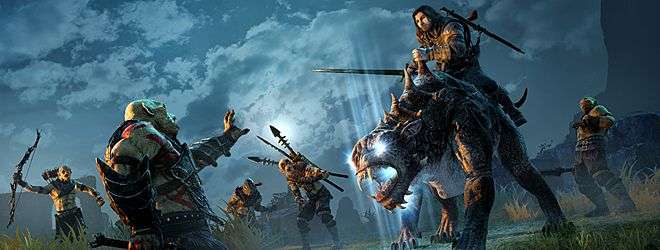
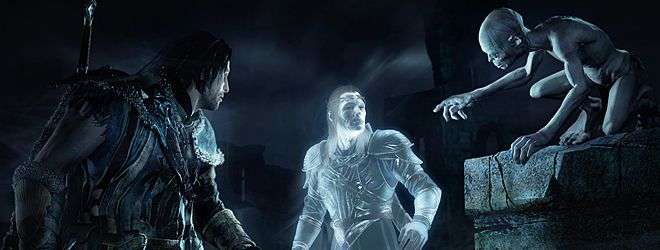
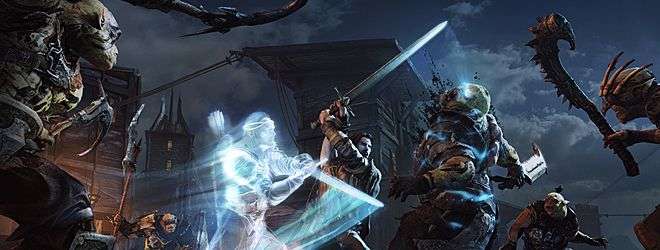
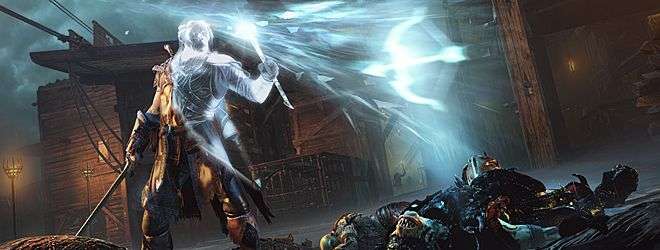
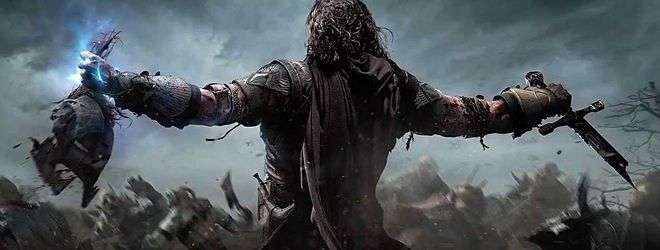
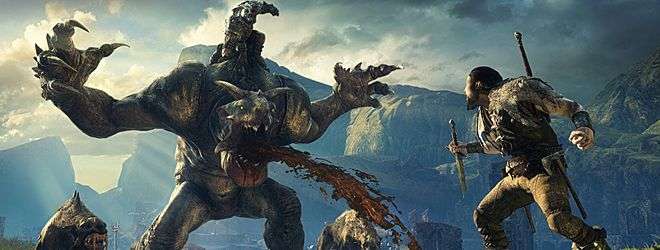






There are no comments, yet.
Why don’t you be the first? Come on, you know you want to!